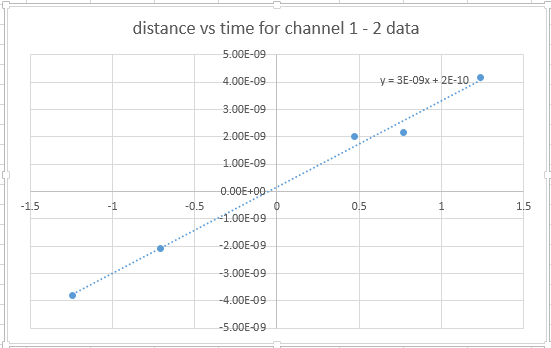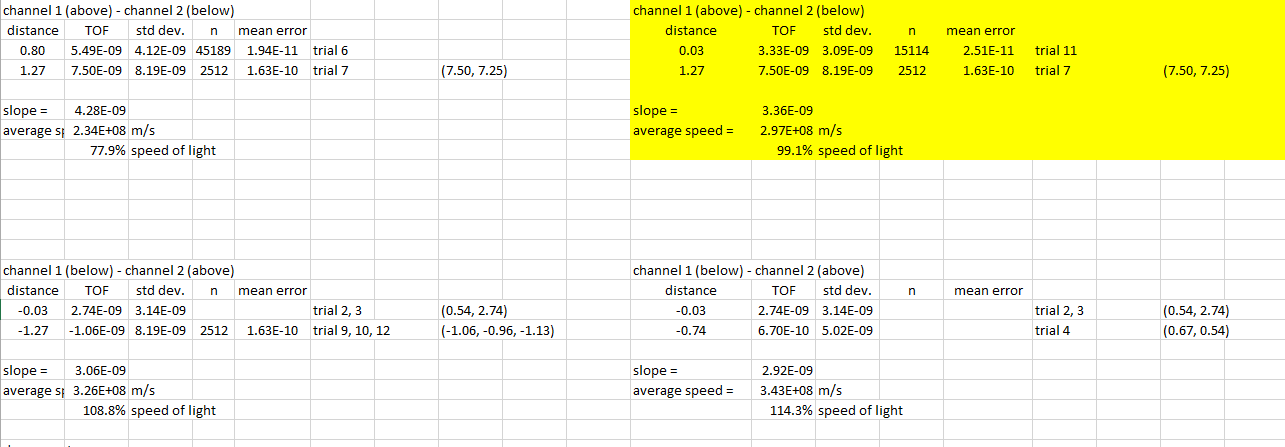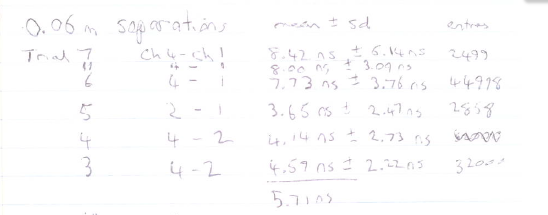Muon Time of Flight Study
Using Muon ToF Data to Determine the Muon Speed
06/09/2016
Abstract
The purpose of this study was to determine muon speed using muon time of flight data collected by experiment, and to assess the experimental procedure in terms of repeatbility and ability to yield accurate results given the uncertainties in the measurement data.
Introduction
The earth is hit by elementary particles and atomic nuclei of very large energies. Most of them are protons (hydrogen nuclei) and all sorts of nuclei up to uranium (although anything heavier than nickel is very, very rare). Those are usually meant when talking about cosmic rays. Other energetic particles in the cosmos are mainly electrons and positrons, as well as gamma-rays and neutrinos.
The cosmic rays will hardly ever hit the ground but will collide (interact) with a nucleus of the air, usually several ten kilometers high. In such collisions, many new particles are usually created and the colliding nuclei evaporate to a large extent. Some of these particles are called muons. Muons have a negative charge the same as an electron, but they are about 200 times more massive.
Using the time of flight (ToF) analysis module available online, we can measure the average time muons take to travel between two counters. We can use this ToF to calculate average speed (v = d/t).
Procedures
1. Set up and calibrate a CRD detection system.
2. Place three scintillation counter in a stacked configuration one on top of the other.
3. Update the geometry at https://www.i2u2.org/elab/cosmic/geometry
4. Configure the data collection for 3-fold coincidence and check the appropriate channels.
5. Begin the collection for 1 hour.
6. At the end of the hour, upload the data file to to https://www.i2u2.org/elab/cosmic/data/upload.jsp.
7. Use the ToF analysis module to generate the histograms required to determine mean time of flight and standard deviation for each combination of scintillator paddles. Check for reasonableness, given that ToF should be least for plates closest together, and greater for plates further apart.
8. Place one scintillator paddle 2 m above the other two paddles and update the geometry at https://www.i2u2.org/elab/cosmic/geometry
9. Configure the data collection for 3-fold coincidence and check the appropriate channels.
10. Begin the collection for 1 hour.
11. At the end of the hour, upload the data file to to https://www.i2u2.org/elab/cosmic/data/upload.jsp.
12. Use the ToF analysis module to generate the histograms required to determine mean time of flight and standard deviation for each combination of scintillation counters. Check for reasonableness, given that ToF should be least for plates closest together, and greater for plates further apart.
13. Enter distance and mean ToF data into a spreadsheet and generate a line of best fit.
Results
| distance (cm) | ToF (ns) | std. dev. (ns) | no. of events | mean error (ns) | |
| 3 | 3.33 | 3.09 | 15114 | 0.025 | |
| 80 | 5.49 | 4.12 | 45189 | 0.019 | |
| 127 | 7.5 | 8.19 | 2512 | 0.16 | |
| -3 | 2.74 | 3.14 | |||
| -127 | -1.06 | 8.19 | 2512 | 0.16 |
Figures

Figure 1. This graph displays distance (m) vs ToF (ns) data for ch 1 - ch 2. The inverse of the best fit slope is the average calculated value of the muon speed.

Figure 2. This spreadsheet data summarizes procedurally collected data for ch 1 - 2.

Figure 3. screen capture for trial 11 ToF analysis

Figure 4. ToF study summary of data - 1

Figure 5. ToF study summary of data - 2





Discussion and Conclusions
The study supports the validity of the method for determining muon speed, but accuracy is an issue. Further work is needed at greater separations of the scintillator paddles to obtain larger mean values without increasing standard error. Separations of greater than 2 m are recommended.
Bibliography
https://www.i2u2.org/elab/cosmic/analysis-lifetime/tutorial.jsp